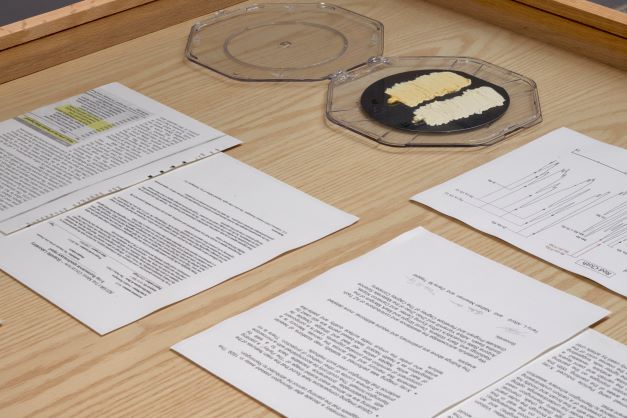Blog - Guadalajara Jalisco - Mexico
Reading time: 3 minutes

11.06.2022
from February 4 to June 18 / 2022



Taking the form of an experimental laboratory or studio Superfake/The Parley (2016) features images, video and delectable works by the Danish artist collective SUPERFLEX. The original project was commissioned by Arizona State University Art Museum (ASUAM) in 2016, and revolves around a painting of questionable provenance from ASUAM’s founding art collection of the 1950s. While the work was originally attributed to famed American Western painter Frederic Remington (1851-1909), it had been called into question in recent years. Superfake/The Parley uses this work as a starting point to examine issues of authenticity, reproduction, and value systems.
While in residence at ASU, SUPERFLEX worked with a team of scientists to conduct key research and determine the genealogy of the painting. In addition, scientific testing focused on various levels of understanding, from the atomic to the microscopic to the visual. The process incorporated all the research methods used to authenticate artworks, based on three main factors: provenance (the paper trail from the artist to the owner), connoisseurship (opinions of experts) and science (material and DNA testing).
Well known for his depictions of cowboys and Indians, Frederic Remington was an extremely successful artist of the late 19th and early 20th century. His imagery was frequently published in his day and subsequently collected by museums to the extent that his vision helped shape the global perception of the great American West, even though his subjects often mixed fact with fiction. SUPERFLEX was interested in the social impact Remington had as a storyteller and artist within the American West genre.
Additionally, Superfake/The Parley brings into question the cultural misconceptions that arise from famous depictions of historical events that are actually an amalgamation of truth and fabrication. The project investigates how artworks are mythologized and valued. Ultimately, as the research uncovered the beloved Remington to be inaccurately attributed, Superfake/The Parley confronts the emotional value of an artwork. As the painting’s value is decreased to one-tenth of its original amount, would the SUPERFLEX project add value to this on-going legend of the painting itself?
Superfake/The Parley features a striking video reenactment of the Remington painting. Shot at 1,000 frames a second using a Phantom camera, the Arizona landscape and the two subjects of the painting—a cowboy and a native on horseback—come to life in slow motion. Other visual imagery includes infrared and x-ray photography, along with scientific data and documentation of the original painting’s provenance. This project is the third iteration of Superfake/The Parley, the first being at ASUAM in (2016). The second at Lunds Konsthall in Sweden in (2016) explored issues related to identity and migration as it explored the timeframe of the painting which coincided with a massive migration of Swedes to the United States in search for a better life but treated as second-hand citizens. The exhibition told first-hand stories about migrant lives and struggles that resonate with contemporary Latin American immigrants’ experience in the US. The third version of Superfake/The Parley in Guadalajara in 2022 brings a new perspective to the mythology of the West by questioning the authenticity of the US cowboy culture that derives from the Vaqueros of the Jalisco region but ignores those roots.
The new commission by Ayer with SUPERFLEX takes the form of non-alcoholic Mezcal, a fake of the real. It tastes the same as the alcoholic Mezcal—the cultural artifact and chosen drink of the Vaqueros—and thereby confronts the mythology of the West and begs the question of whether the emotional value adds to the cultural one.
Julio César Morales
Comments
There are no coments available.